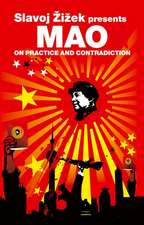Muslim National Communism in the Soviet Union: A Revolutionary Strategy for the Colonial World: Publications of the Center for Middle Eastern Studies, cartea 11
Autor Alexandre A. Bennigsen, S. Enders Wimbushen Limba Engleză Paperback – 31 aug 1980
In this study, Bennigsen and Wimbush trace the development of the doctrine of national communism in Central Asia and the Caucasus. At the heart of this doctrine—as elaborated by the Volga Tatar, Mir-Said Sultan Galiev—was the concept of "proletarian nations," as opposed to the traditional notion of a working class. With such ideological innovations, Sultan Galiev and his contemporaries were able to reconcile Marxist nationalisms and Islam and devise an "Eastern strategy" whereby the national revolution was to be spread.
The authors show that the ideas of Muslim national communism persist in the land of their birth and have spread to such developing societies as China, Algeria, and Indonesia. This doctrine is an important factor in the ideological split and increasing tensions between industrial and nonindustrial nations, East and West, and now North and South, which grip the world communist movement.
The authors show that the ideas of Muslim national communism persist in the land of their birth and have spread to such developing societies as China, Algeria, and Indonesia. This doctrine is an important factor in the ideological split and increasing tensions between industrial and nonindustrial nations, East and West, and now North and South, which grip the world communist movement.
Preț: 286.51 lei
Nou
Puncte Express: 430
Preț estimativ în valută:
54.82€ • 57.40$ • 45.47£
54.82€ • 57.40$ • 45.47£
Carte tipărită la comandă
Livrare economică 09-23 aprilie
Preluare comenzi: 021 569.72.76
Specificații
ISBN-13: 9780226042367
ISBN-10: 0226042367
Pagini: 290
Dimensiuni: 149 x 229 x 15 mm
Greutate: 0.32 kg
Ediția:Revised
Editura: University of Chicago Press
Colecția University of Chicago Press
Seria Publications of the Center for Middle Eastern Studies
ISBN-10: 0226042367
Pagini: 290
Dimensiuni: 149 x 229 x 15 mm
Greutate: 0.32 kg
Ediția:Revised
Editura: University of Chicago Press
Colecția University of Chicago Press
Seria Publications of the Center for Middle Eastern Studies
Cuprins
Acknowledgments
A Note on Transliteration
Introduction
1. From National Socialism to National Communism
The Transfer of Socialist Ideas
The Relevance of Socialism to Nationalist Elites
Conclusion
2. The Impact of Revolution and Civil War
Typologies of the New Bolsheviks
3. National Communism
The Ideological Basis
A "Muslim Way" to Communism
The Eastern Strategy
The Struggle for Organizational Independence
The Republic of Turan: A Revolutionary Springboard
4. The Struggle for Power and the Liquidation of the National Communists
Self-Determination and Counterrevolution
The Southern Border: Turkey, Iran, and the Republic of Ghilan
Twelfth Party Congress and the Purge of Sultan Galiev
The National Communists Fight Back
The Turning Point: 1928
A Note on Rehabilitations
5. The Legacy of Muslim National Communism
Muslim National Communism's Legacy in the USSR
National Communism beyond the Borders of the Soviet Union
6. Conclusion and Prospects
Appendix A. The Social Revolution and the East
Appendix B. The Tatars and the October Revolution
Appendix C. The Methods of Antireligious Propaganda among the Muslims
Appendix D. Rights and "Lefts" in the National Republics and Regions
Appendix E. The Program of the ERK Party
Appendix F. Demographics of Soviet Muslim Nationalities
Appendix G. Chronology, 1917-28
Appendix H. Biographies
Appendix I. Political Parties
Appendix J. Glossary
Notes
Bibliography
Index
A Note on Transliteration
Introduction
1. From National Socialism to National Communism
The Transfer of Socialist Ideas
The Relevance of Socialism to Nationalist Elites
Conclusion
2. The Impact of Revolution and Civil War
Typologies of the New Bolsheviks
3. National Communism
The Ideological Basis
A "Muslim Way" to Communism
The Eastern Strategy
The Struggle for Organizational Independence
The Republic of Turan: A Revolutionary Springboard
4. The Struggle for Power and the Liquidation of the National Communists
Self-Determination and Counterrevolution
The Southern Border: Turkey, Iran, and the Republic of Ghilan
Twelfth Party Congress and the Purge of Sultan Galiev
The National Communists Fight Back
The Turning Point: 1928
A Note on Rehabilitations
5. The Legacy of Muslim National Communism
Muslim National Communism's Legacy in the USSR
National Communism beyond the Borders of the Soviet Union
6. Conclusion and Prospects
Appendix A. The Social Revolution and the East
Appendix B. The Tatars and the October Revolution
Appendix C. The Methods of Antireligious Propaganda among the Muslims
Appendix D. Rights and "Lefts" in the National Republics and Regions
Appendix E. The Program of the ERK Party
Appendix F. Demographics of Soviet Muslim Nationalities
Appendix G. Chronology, 1917-28
Appendix H. Biographies
Appendix I. Political Parties
Appendix J. Glossary
Notes
Bibliography
Index


















